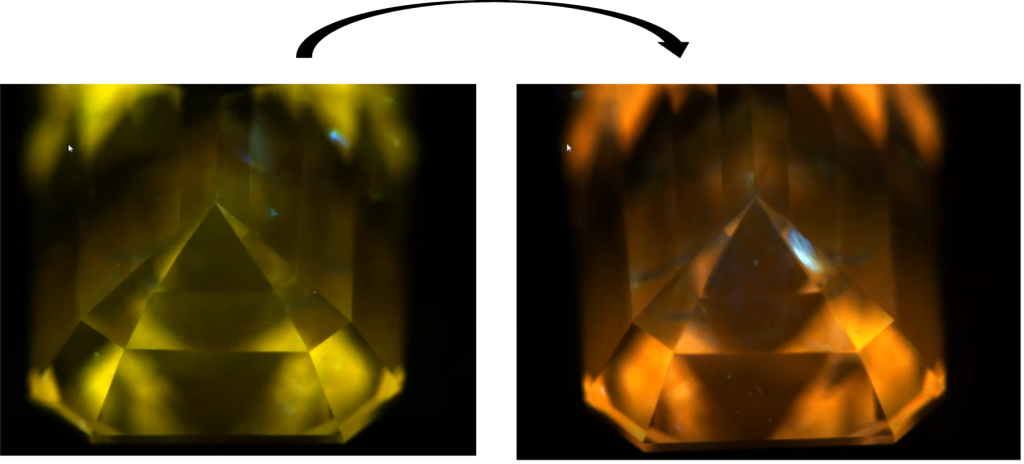GSI Lab Note: Rare phosphorescence in CVD Lab Grown Diamond
Authors: Deepa Srinivasa, Dr. Ramchandra Patil, Bharanidharan K, Prathamesh Bare
Lab Grown Diamonds have gained increased popularity in recent times. Today’s cutting-edge technology has made it possible to replicate a diamond’s natural growth in highly controlled environments. The result has been the production of lab grown diamond in a few days, or weeks, with minimum investment. Lab grown diamonds are identical to a mined diamonds chemically, physically, and optically, but cost about 50% less.
CVD (Chemical Vapor Deposition) and High pressure and High temperature (HPHT), are the most common lab grown diamond manufacturing processes, and each of the methods have their own distinguishing factors, enabling gemologists and well-equipped labs to identify them.
CVD lab grown diamonds shows distinct fluorescence when exposed to a conventional SWUV (Short-wave Ultra-Violet) lamp (280-315 nm). Typical SWUV reaction observed in CVD lab grown diamonds are orange, yellow, green, violet or blue fluorescence colors. Prolonged exposure to SWUV may have some effect, and a change in fluorescence color can be observed (Eaton-Magaña & Shigley 2016, Wang et al., 2003, 2005, 2007, 2010, 2012).
Recently our interest was drawn to a CVD lab grown diamond weighing 1.547 ct., emerald cut, VS1 clarity and H color, which was submitted to the Gemological Science International (GSI) Mumbai Lab for Post Growth Treatment Identification.
The absorption spectra in the mid-infrared region showed typical absorption features of type IIa, as seen in CVD lab grown diamonds. No additional absorption features were observed. (Fig.1)

Photoluminescence spectroscopy with 532 nm excitation showed peaks at 737, 637 and 575 nm (Fig.2). The 737 nm and 766 nm emission systems are associated with silicon-vacancy centers, including moderately strong NV emission lines at 575 and 637 nm (Clark et al.,1995).

Fig.2: Photoluminescence spectroscopy with N-V centres and Si-V peaks of CVD 1.547ct, emerald cut.
Raman microscope with 532 nm spectrometers showed extremely strong NV emission lines at 575 and 637 nm, absence of 596/597 nm doublet indicates post-growth treatment. (Fig.3) (Clark et al.,1995).

Fig.3: Raman microscope spectroscopy with N-V centres related peaks of CVD 1.547ct, emerald cut.
DiamondView revealed a strong greenish yellow fluorescence when observed length wise, and interestingly, on a rotation of 180 degrees ,a strong orange fluorescence was observed. (Fig.4)

Fig.4. Greenish yellow fluorescence (left), on rotation of 180 degrees strong orange color observed.
Most CVD in DiamondView have shown orange, red, blue and sometimes mottled distribution of purple, red, and blue fluorescence color. The phosphorescence is usually inert, but in some rare instances, variable degrees of weak blue-green phosphorescence has been observed. Studies have revealed that these variable fluorescence color and phosphorescence intensities could be related to the growth of CVD lab grown diamonds. The change in the fluorescence colors could be due to the defects in the internal crystal plane. (Lu, Q. et al.,2021).
Due to prolonged observation in DiamondView, when the DiamondView was turned off, an intense red phosphorescence for a few milliseconds (10-15 milliseconds) was observed which quickly changed to yellow (Fig.5). Such observations have not been reported earlier in CVD diamonds. This intense red phosphorescence was observed only after prolonged exposure to DiamondView.

Fig.5. Phosphorescence seen post UV excitation for milli seconds only
The possible reason for different fluorescence colors, in different direction and phosphorescence, is assumed could be due to inconsistent lattice defects during the CVD growth process.
Deepa Srinivasa, Chief Gemologist at GSI, is head of research and development, based out of Mumbai. A highly qualified and experienced gemologist and educator, she has over two decades of experience in the industry, working with leading institutions in gemology. Deepa’s in-depth gemological education was attained studying at highly acclaimed foundations, including: University of Nantes, France, GEM-A UK, SSEF Switzerland, GIA and GII. Her executive education includes luxury and brand building from some of the most reputed organizations, including: Università Bocconi, London Business School, Luxury Academy London, Harvard University and Luxury Connect Business School. Deepa Srinivasa also specializes in the identification and origin determination of gemstones.
References:
Wang W., Moses T., Linares R., Shigley J.E., Hall M., Butler J.E. (2003) Gem-quality synthetic diamonds grown by a chemical vapor deposition (CVD) method. G&G, Vol. 39, No. 4, pp. 268– 283, http://dx.doi.org/10.5741/GEMS.39.4.268
Wang W., Smith C.P., Hall M.S., Breeding C.M., Moses T.M. (2005) Treated-color pink-to-red diamonds from Lucent Diamonds Inc. G&G, Vol. 41, No. 1, pp. 6–19, http://dx.doi.org/ 10.5741/GEMS.41.1.6
Wang W., Hall M.S., Moe K.S., Tower J., Moses T.M. (2007) Latest generation CVD-grown synthetic diamonds from Apollo Diamond Inc. G&G, Vol. 43, No. 4, pp. 294–312, http://dx.doi.org/ 10.5741/GEMS.43.4.294
Wang W., Doering P., Tower J., Lu R., Eaton-Magaña S., Johnson P., Emerson E., Moses T.M. (2010) Strongly colored pink CVD lab-grown diamonds. G&G, Vol. 46, No. 1, pp. 4–17, http://dx.doi.org/10.5741/GEMS.46.1.4
Wang W., D’Haenens-Johansson U.F.S., Johnson P., Moe K.S., Emerson E., Newton M.E., Moses T.M. (2012) CVD synthetic diamonds from Gemesis Corp. G&G, Vol. 48, No. 2, pp. 80– 97, http://dx.doi.org/10.5741/GEMS.48.2.80
Eaton-Magaña, S. & Shigley, J.E. 2016. Observations on CVD-grown synthetic diamonds: A review. Gems & Gemology, 52(3), 222–245, https://doi.org/10.5741/ gems.52.3.222.
Clark, C.D., Kanda, H., Kiflawi, I., and Sittas, G., 1995. Silicon defects in diamond. Physical Review B, 51, 16681–8.
Lu, Q.; Gong, H.; Guo, Q.; Huang, X.; Cai, J. Gemological Characteristic Difference between Colorless CVD Synthetic Diamonds and Natural Diamonds. Materials 2021, 14, 6225. https://doi.org/ 10.3390/ma14206225.